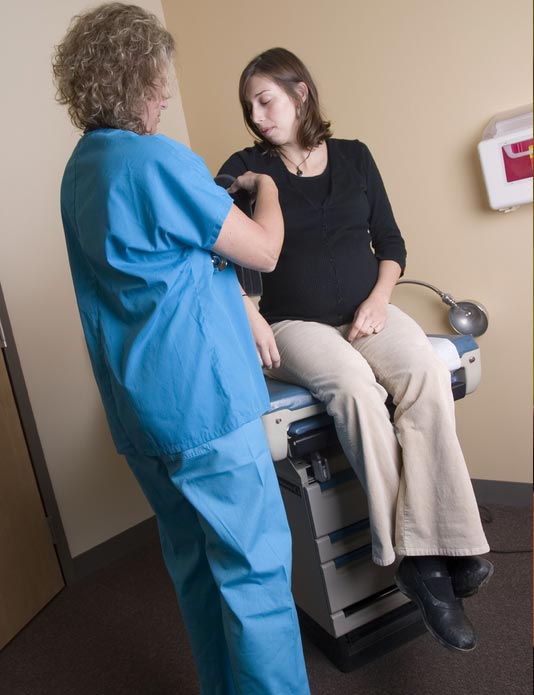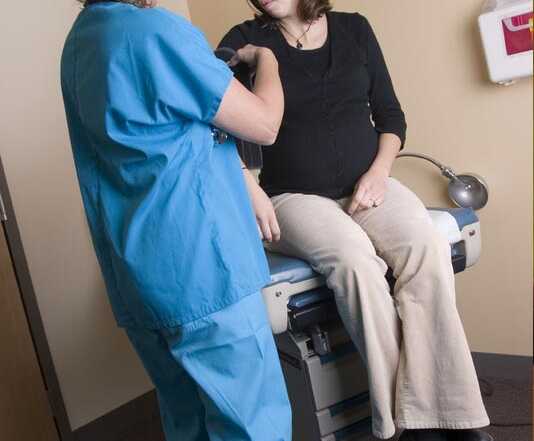
Thriftway Pharmacy Gestational Diabetes
Gestational diabetes mellitus (GDM) is a kind of diabetes that develops only during pregnancy. (Gestation is another word for pregnancy.) GDM usually develops between the 24th and 28th weeks of pregnancy and will probably go away when the baby is born.
Our bodies use the food we eat to get the sugar we need for energy. Insulin is a chemical made by our pancreas. It helps the sugar leave the blood and go into our body cells, where it is used as a kind of fuel. When this happens the way it should, the level of sugar in the blood goes down and our bodies have the energy for a full and active life.
In people with diabetes, this system In people with diabetes, this system doesn’t work. When you have diabetes, your body can’t use the energy from the food you eat. Sugar stays in the blood instead of going into the cells of the body.
Who Gets GDM?
Women who are over 30 years old, are obese, or have a family history of diabetes have the greatest chance of getting GDM. I But it can happen to any pregnant woman! GDM usually can’t be prevented. If you have had GDM in one pregnancy, you are likely to have it again in later pregnancies.
GDM occurs in up to 3% (3 of 100) of all pregnant women, but it is much more common in: Hispanic Americans, African Americans, Native Americans.
How Do I Know If I Have GDM?
GDM usually has no symptoms. That’s why all pregnant women should be checked for it. A blood test is the only way to be sure you have it. If you have had GDM in an earlier pregnancy, your doctor should test for it at your first visit for this pregnancy.
If you have never had GDM before, your doctor should test for it between the 24th and 28th weeks of your pregnancy.
How Is The Test Done?
When you are checked for GDM, you will be asked to drink a sugary drink and have a blood test 1hour later. You can eat normally before this test. If the results are above a certain level, you will be asked to take a 3-hour glucose (sugar) tolerance test (GTT). It is important to do this test as (GTT). It is important to do this test as soon as possible. It is also important that you not eat or drink anything on the morning of the test. This test will tell your doctor whether you have GDM. If so, you will need to be treated at once.
What Does Having GDM Mean For Me And My Baby?
During pregnancy, everything the baby needs to grow and be healthy comes from the mother. Things like vitamins, minerals, and sugar are carried to the baby in the mother’s blood. If everything works as it should, the mother and baby will both have the energy they need. In GDM, this process doesn’t work. Instead of being used for energy, sugar builds up in the blood. High blood sugar levels are unhealthy for both the mother and the baby.
Will GDM Hurt My Baby?
GDM will not cause your baby to have diabetes after it is born. In fact, if you keep
your blood sugar in the normal range (see Test your blood sugar) during pregnancy, you have a very good chance of having a healthy baby. If not, your baby can have some serious problems.
Large Birth Size
When you have higher than normal blood sugar, a lot of the extra sugar goes to your baby. The baby’s body then makes extra insulin in an effort to lower its blood sugar. This extra sugar and insulin cause the baby to grow very big. Large birth size can make delivery harder for you and the baby. A surgical operation called a “cesarean section” is sometimes needed to help deliver a big baby.
Low Blood Sugar In The Baby After Birth
If you had high blood sugars during pregnancy, your baby’s body will have gotten used to making extra insulin to keep up. Your baby will continue making extra insulin after birth, when it is no longer needed. This extra insulin can cause your baby’s blood sugar to drop very low. This is called hypoglycemia, and it is a very serious condition. It is most likely to occur if your blood sugars were high during the last few days before delivery. Your baby’s blood sugar level will be checked often for several hours after birth.
Jaundice
A slightly yellow skin color (jaundice) is fairly common in babies. It is due to a build- up of a body chemical called bilirubin. A certain amount of this build-up is normal and is rarely a serious problem. Usually it goes away by itself.
Jaundice is more likely to be severe in babies of mothers with GDM. Sometimes these babies need to receive a special kind of light treatment to help break down the extra bilirubin that has built up in their bodies.
Other Problems
Now that there are easy ways to check the baby before and during birth, stillbirth rarely occurs with GDM. High blood sugar can cause early birth. Babies can have serious breathing problems if they are born early, before their lungs are fully developed.
How Can GDM Affect Me?
Difficult labor and cesarean delivery
Most women with GDM deliver healthy babies. If blood sugar has been well-controlled during pregnancy and the baby is a normal size, most women can have a regular vaginal delivery. If your baby is large, your labor may be difficult and you may need to have a cesarean delivery. It will take you longer to heal after a cesarean delivery. Although millions of babies are born safely by cesarean delivery each year, any kind of surgery increases the risk of problems.
Increased risk of infection
Women with GDM may have a greater chance of getting infections. Vaginal, bladder, and kidney infections are the most common kind. Having an infection will usually mean antibiotic treatment. Your doctor may do monthly urine cultures to look for infections.
Toxemia
Women with GDM sometimes develop a serious complication of pregnancy called toxemia. It causes high blood pressure and swelling. This is unhealthy for both the mother and the baby, and needs prompt treatment. It usually means going into the hospital or staying in bed. Toxemia generally goes away after delivery.
Does diabetes end after pregnancy?
The most serious problem for the mother with GDM is that diabetes may not go away after pregnancy. This happens to about 2% (2 of 100) of all women with GDM. Another 8% (8 of 100) have blood sugars that are higher than normal, but not high enough to be called diabetes. (This is called “impaired glucose tolerance.”) Up to 60% (60 of 100) of women who have had GDM will get diabetes later in life. Obese women have the greatest risk of developing lifelong diabetes.
What Can I Do To Take Care Of Myself And My Baby?
The goal of caring for GDM is to keep your blood sugar levels as close to normal as possible. By keeping blood sugars normal, you do the best you can to keep your baby healthy. There are several “tools” that will help you do this.
Work with a health care team
Before being diagnosed with GDM, you were probably cared for by your regular doctor or obstetrician. Now you may need additional help. The best way to get this care is from a team of experts. Your team may include: an endocrinologist (a doctor who is an expert in diabetes). a perinatologist (a doctor who is an expert in high-risk pregnancies). a Certified Diabetes Educator (CDE). a Registered Dietitian (RD).
Follow your meal plan
A Registered Dietitian will help you come up with a healthy, well- balanced meal plan. Your meal plan will be just for you, and will, include many of the foods you usually like to eat. Following this meal plan will be your key to success with GDM. It is important to include all of the basic food types, including starches, in your meal plan. Taking starches out of your diet entirely could be harmful to your baby. The meal plan you get from your dietitian will help you balance your meals, especially the amount of starches you need, throughout the day. And, it will include all the foods you need for a healthy baby. Meal plan goals are normal blood sugar (see Test your blood sugar). a total pregnancy weight gain of 25 to 35 pounds. no Ketones in your urine(more about this letter). You should avoid; caffeine, alcohol, concentrated sweets, fruit or bagels at breakfast, and artificial sweeteners containing saccharin. See the Managing Your Diabetes brochure on “Planning Your Meals” for more information.
Test your blood sugar
Testing your blood sugar is a good way to tell how well you’re doing. Since blood sugars change throughout the day, you will probably be asked to test four times a day. Blood sugars are generally lowest before meals and highest one hour after meals.
When to test: before breakfast 1 hour after breakfast. 1 hour after lunch. 1 hour after dinner.Your blood sugars are likely to be their highest at these times of day. Your baby will do well if your test results are in the normal range at these tests.
Blood sugar goals for women with GDM are the same as in normal pregnancy. Meeting these goals during pregnancy will reduce the risks for you and your baby.
Ideal blood sugar values
Before breakfast 60 to 90 mg/dL
2 hours after meals < 120 mg/dL
It’s Easy To Do
Your diabetes educator or pharmacist can show you how. You will need: a small drop of blood. There are automatic devices you can use to make this simple, quick, and almost painless. a testing meter. There are many different types. When you place your blood on a special test strip, the meter will “read” your blood sugar level.
Most insurance plans pay for the cost of blood sugar testing during pregnancy.
Test Your Urine Ketones
When possible, our body’s cells burn sugar to get energy. But blood sugar cannot be used for fuel when there’s not enough insulin to help. When this happens, your blood sugar stays too high. That is very dangerous.
If this happens, your body will burn fat as another fuel source. The problem is that when the body uses fat in this way, waste products called ketones are formed. Ketones build up in the blood and spill into the urine. Because ketones are more acidic than healthy body tissues, high levels of ketones change your body’s normal chemistry. Ketones also pass through the placenta and are dangerous for the baby.
You may make ketones during pregnancy if:
- It has been a long time between meals.
- You are not eating enough calories or carbohydrates.
What you can do?
Check your urine for ketones every morning before eating. The test is very easy to do. Eat a snack before bedtime. This will usually protect you during the night. Do not skip or delay meals. Eat the amount of starch that’s been planned for each meal.
Exercise
Exercise lowers blood sugar. Taking a brisk, 20- to 30- minute walk after meals can help control blood sugar. Many women find that a walk after breakfast is especially helpful. Some women need to walk after each meal to keep their sugar levels normal.
Moderate exercise is usually okay. Your heart rate should not get above 140 beats per minute. Do not exercise for more than 30 minutes at a time. If you exercise too hard or too long, your body may get too hot. Talk to your doctor before starting any type of exercise program.
Good forms of exercise during pregnancy include: brisk walking, swimming, pre-natal stretching exercise.
Activities that may be too much for you to do during pregnancy include:Jogging, tennis, racquetball, volleyball, and water skiing.
If You Need More Help
If your meal plan and exercise do not keep your blood sugar in the normal If you range, your doctor may suggest treatment with insulin. Insulin is used in 20% to 50% (20 to 50 of 100) of women with GDM. Insulin must be given as a shot.If you need insulin, a diabetes educator can teach you to give yourself the shots. Today’s needles are so thin that insulin shots are virtually painless. Your diabetes educator will also teach you:
the names and types of insulin you will use. (Human insulin is usually the only insulin recommended.’)
When To Take Insulin And How Much Insulin To Take.
The amount of insulin you need will increase as your pregnancy goes along. This is not a sign that you are doing anything wrong or that your diabetes is getting worse. Needing more insulin is just a normal result of your baby’s growth.
How to balance your insulin with your meals.
How to avoid low blood sugar reaction (hypoglycemia).
Any change of insulin should be made cautiously and only under medical supervision.
Taking insulin is safe for your baby
Insulin does not cross the placenta, but blood sugar does. High blood sugar is very dangerous for your baby. If insulin is needed to keep your blood sugars near normal, it is the healthy thing for your baby!
Keeping records
It is important for you to keep a record of: your blood sugar test results. Your urine ketone test results. Any change in your diet, exercise, or insulin.Your health care team will want to check records at each visit. That’s how they know when changes are needed in your treatment plan. Your baby’s safety depends on these results.
Follow Up Tests Your Doctor Will Do
If you have GDM, your doctor may want to see you more often. Startin around the 34th to 36th week of pregnancy, your doctor will start doing tests to see how your baby is doing and measure the baby’s growth. Some of the more common tests include:
ultrasound (sonogram). This is a safe and painless test. It uses sound waves to make a picture of the baby. Ultrasound may be done every 1 to 4 weeks near the end of pregnancy. Many doctors order an ultrasound to check
the baby’s size before choosing the safest way to deliver the baby.
Kick counts (fetal movement records).
The kicks you feel from your baby are a good way of checking on the baby’s health. You may be asked to count the number of times your baby moves
during a period of time each day. The doctor or nurse will teach you how. Call your doctor at once if you notice any decrease in the number of kicks or any change in the pattern of the baby’s movements.
Non-stress testing (NST).
NST is a painless test that uses a microphone to record the baby’s heartbeat. The baby’s heart should beat faster during movement. This test is usually done once or twice a week near the end of pregnancy.
The biophysical profile.
This test combines an ultrasound with an NST. This test may be done as often as once a week near the end of pregnancy.
After Delivery
Breast-feeding
GDM doesn’t affect your ability to breast feed your baby. Breast milk is a good source of infant nutrition and helps the baby fight infections. Breast-feeding can also help you lose weight.
Post-partum (after delivery) check-up
It is very important for you to have another glucose tolerance test 6 weeks after your baby is born. This will let you and your I doctor know for sure that your diabetes is gone. In over 90% (90 in 100) of women with GDM, diabetes goes away after delivery.
Some women have blood sugars that are too high to be normal, but too low to be diabetes. This is called “impaired glucose tolerance.” If you still have diabetes or impaired glucose tolerance, it’s very important that you receive regular medical care. Even if you have normal blood sugars after birth, you need to take extra care. Have a fasting blood test done once a year to make sure that your blood sugars stay in the normal range.
Future Pregnancies
If you have had GDM once, you are more likely to have it again in later pregnancies With each pregnancy, you should have a screening test at your first doctor’s visit. If the test is normal, you should be checked again at 24 to 28 weeks.
Your Future Health
Staying active and a healthy weight are the most important tools to prevent future diabetes About one-half of all woman who have had GDM eventually develop diabetes. It may happen years after your baby Is born. therefore, it’si mportant that you be checked for diabetes regularly. To start with, you should have a glucose tolerance test at your first doctor visit after you have your baby. And it is also a good idea to learn the symptoms of Type II diabetes, so that you can watch for them. But most importantly, you should have your blood sugar tested before becoming pregnant again.
A Final Word
GDM is a problem you and your baby can live with. Just remember to: work with your health care team follow a healthy meal plan. test your blood sugar and urine ketones often. stay active, maintain a healthy weight. If you do, you should be able to control your blood sugar and have a healthy baby.
Remember, your baby needs you!
Planning your Meals
Eating healthy foods is one of the basic tools of diabetes care. [...]
Gestational Diabetes
Thriftway Pharmacy Gestational Diabetes Gestational diabetes mellitus (GDM) is a [...]
Traveling with diabetes
Are you going on vacation? ... taking a business trip? ... visiting [...]
Caring for your feet
It is important to take special care of your feet when you [...]
Exercising with diabetes
Exercise is good for everyone. But it can be especially good for [...]
Diabetes Center
If you have diabetes, you know that it can cause serious problems, [...]







